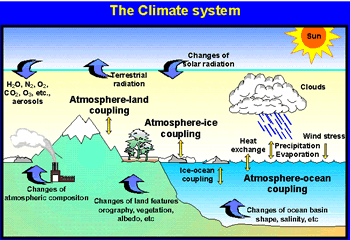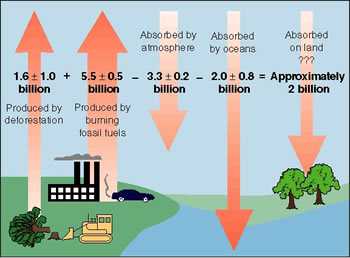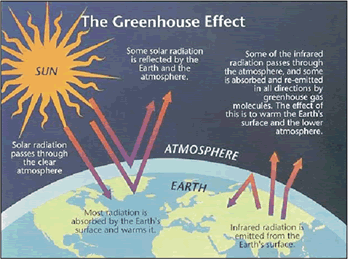|
|
 |  | 
| Print this Brief |
| What
causes global climate change? |
| |
Key
Points
There is a scientific consensus that
concentrations of greenhouse gases in the atmosphere
are increasing and that this is causing global climate
change. Human-driven emissions of carbon dioxide
and other greenhouse gases, as well as land-use change,
are the processes primarily responsible for the increase.
Emissions of black carbon (soot) may also be contributing
to the warming. Emissions of reflective sulfate aerosols
have been associated with a net cooling effect.
Defining Weather
and Climate
Weather is
the state of the atmosphere at a specific time in
a specific place. Temperature, cloudiness, humidity,
precipitation, and winds are examples of weather
elements. Thunderstorms, tornadoes, and monsoons
are also part of the weather of some places during
some seasons.
Climate is
defined as long-term weather patterns that describe
a region. For example, the New York metropolitan
region’s climate is temperate, with rain evenly
distributed throughout the year, cold winters, and
hot summers.
Climate Variability and Climate Change
Climate variability refers to variations
in the prevailing state of the climate on all temporal
and spatial scales beyond that of individual weather
events. Variability may be due to natural internal
processes within the climate system, or to variations
in natural or anthropogenic (human-driven) external
forcing. Global climate change indicates a change
in either the mean state of the climate or in its
variability, persisting for several decades or longer.
This includes changes in average weather conditions
on Earth, such as a change in average global temperature,
as well as changes in how frequently regions experience
heat waves, droughts, floods, storms, and other extreme
weather. It is important to note that changes
in individual weather events will potentially contribute
substantially to changes in climate variability.
Climate change could occur naturally
as a result of a change in the sun’s energy
or Earth’s orbital cycle (natural climate forcing),
or it could occur as a result of persistent anthropogenic
forcing, such as the addition of greenhouse gases,
sulfate aerosols, or black carbon to the atmosphere,
or through land-use change.
The Climate System
and the Carbon Cycle
The climate system is driven by the
sun’s energy and regulated by natural processes
and cycles in the Earth system (Figure 1). These
include the carbon cycle and greenhouse effect, orbital
cycles, ocean currents that distribute warmer and
colder water around the globe, and atmosphere-ocean
interactions that moderate temperature. Humans are
principally affecting the climate system through
alterations to the carbon cycle, which regulates
the flow of carbon among living and non-living parts
of the Earth system (Figure 2). Carbon is found in
all living things, in soils and rocks, in fossil
fuels, in ocean sediments and corals, and as carbon
dioxide in the atmosphere. Each of these carbon reservoirs
stores a percentage of the Earth’s total carbon
and carbon moves at varying rates among the reservoirs.
In some cases, the carbon may remain in a reservoir
for millions of years, as in the case of fossil fuels
before the Industrial Revolution. As humans burn
fossil fuels to produce energy and as they clear
natural ecosystems, carbon dioxide is released into
the atmosphere, where it acts as a greenhouse gas.
|
|
|
|
 |
| Figure 1. The
climate system is driven by solar radiation,
atmospheric composition, and interaction
with ocean and land processes. Source:
Commonwealth Scientific and Industrial Research
Organisation (CSIRO), Modelling Climate:
CSIRO Atmospheric Research Greenhouse Information
Paper. Australia 1996. http://www.dar.csiro.au/publications/info98_4.htm |
|
|
 |
| Figure 2. Carbon
cycles through all living things and can
be found in the ocean, atmosphere, rocks,
and soil. Units are in metric tonnes of carbon
per year. Source: United States Geological
Survey (USGS). Global Environmental Change
and the Carbon Cycle. USGS Fact Sheet137-97
1997. http://geochange.er.usgs.gov/pub/carbon/fs97137/co2bdgt90.jpg |
|
|
|
|
|
 |
Figure 3. The
greenhouse effect is responsible for making
the Earth habitable. Source: United States
Global Change Research Information Office,
United States Global Change Research Program,
1996.
http://www.gcrio.org/ocp96/p30box.html |
|
Greenhouse Gases
The presence of greenhouse gases in the atmosphere
is a natural component of the climate system and
helps to maintain the Earth as a habitable planet
(Figure 3). Greenhouse gases are relatively transparent
to incoming solar radiation, allowing the sun’s
energy to pass through the atmosphere to the surface
of the Earth. The energy is then absorbed by the
Earth’s surface, used in processes like photosynthesis,
or emitted back to space as infrared radiation. Some
of the emitted radiation passes through the atmosphere
and travels back to space, but some is absorbed by
greenhouse gas molecules and then re-emitted in all
directions. The effect of this is to warm the Earth’s
surface and the lower atmosphere. Water vapor (H2O)
and carbon dioxide (CO2) are the two largest
contributors to the greenhouse effect. Methane (CH4),
nitrous oxide (N2O), chlorofluorocarbons
(CFCs) and other greenhouse gases are present only
in trace amounts, but can still have a powerful warming
effect due to their heat-trapping abilities and their
long residence time in the atmosphere. Without the
greenhouse effect, Earth’s average temperature
would be -0.4°F (-18°C), rather than the
present 59°F (15°C).
Concentrations of greenhouse gases – and
especially carbon dioxide – have risen over
the past two hundred and fifty years, largely due
to the combustion of fossil fuels for energy production.
Since the Industrial Revolution in the eighteenth
century the concentration of carbon dioxide in the
atmosphere has risen from about 270 parts per million
(ppm) to about 370 ppm. Concentrations of methane
have also risen due to cattle production, the cultivation
of rice, and release from landfills. Nearly one-third
of human-induced nitrous oxide emissions are a result
of industrial processes and automobile emissions.
Land-use Change
The combustion of fossil fuels is not
the only anthropogenic source of carbon dioxide.
When ecosystems are altered and vegetation is either
burned or removed, the carbon stored in them is released
to the atmosphere as carbon dioxide. The principal
reasons for deforestation are agriculture and urban
growth, and harvesting timber for fuel, construction,
and paper. Currently, up to a quarter of the carbon
dioxide emissions to the atmosphere can be attributed
to land-use change.
Sulfate Aerosols
and Black Carbon
Sulfate aerosols and black carbon
are two important additional examples of anthropogenic
forcings. Sulfate aerosols, which enter the atmosphere
naturally during volcanic eruptions, are tiny airborne
particles that reflect sunlight back to space. Industrial
activity has recently increased their concentration
in the atmosphere primarily through the burning of
fossil fuels containing sulfur. Anthropogenic emissions
of sulfate aerosols have been associated with a net
cooling effect.
Black carbon is soot generated from
industrial pollution, traffic, outdoor fires, and
the burning of coal and biomass fuels. Black carbon
is formed by incomplete combustion especially of
coal, diesel fuels, biofuels and outdoor biomass
burning. Soot particles absorb sunlight, both heating
the air and reducing the amount of sunlight reaching
the ground.
Global Climate
Change in the Twentieth Century
The climate system includes a great
deal of natural variability, and climate fluctuations
have always been part of the Earth’s 4.6 billion
year history. However, over the past century changes
in concentrations of greenhouse gases in the atmosphere
are of an unprecedented rate and magnitude. Human
population growth has led to increasing demands for
energy and land resources. Through the burning of
fossil fuels to produce energy for industrial use,
transportation, and domestic power, and through land-use
change for agriculture and forest products, humans
have been altering the Earth’s energy balance.
Scientists believe that these changes may have already
begun to alter the global climate.
References
Intergovernmental Panel on Climate Change (IPCC),
2001. "Working Group I Third Assessment Report." Cambridge
University Press. Cambridge, UK. 881 pp.
National Academy of Sciences (NAS). 2001. "Climate
Change Science: An Analysis of Some Key Questions." National
Academies Press. 42 pp.
Related Resources:
Print version (factsheet
pdf) |
|
 |
 |

